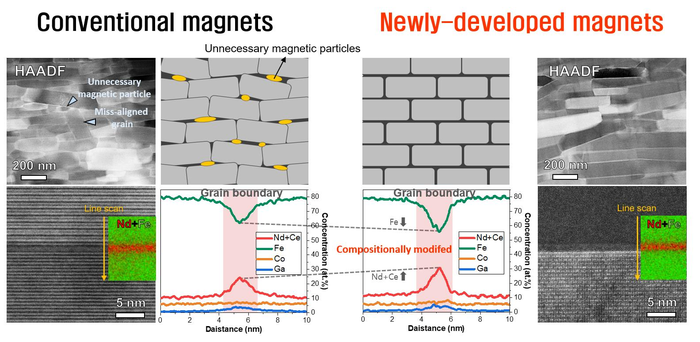Reviewed by Alex SmithApr 25 2022
A government-funded research institute under the Ministry of Science and ICT has proven to be successful in developing rare-earth-saving permanent magnets. This was done by a research group headed by Dr. Jung-Goo Lee and Dr. Tae-Hoon Kim of the Department of Magnetic Materials in the Powder Materials Division at the Korea Institute of Materials Science (KIMS).
 HAADF-STEM images and schematic illustrations of conventional magnets and newly developed magnets. Image Credit: Korea Institute of Materials Science (KIMS).
HAADF-STEM images and schematic illustrations of conventional magnets and newly developed magnets. Image Credit: Korea Institute of Materials Science (KIMS).
These newly-developed magnets could replace the 42M-graded commercial magnets while decreasing the amount of neodymium (Nd), a high-priced rare-earth, by around 30%. The technology has a considerable value as it has been achieved by the commercial magnet-level of performance. This is utilized at present in the industry, although the amount of expensive rare-earth resources has been decreased.
Neodymium (Nd) is costly and unsteadily supplied, but its use is an unavoidable one as it is necessary for manufacturing rare earth permanent magnets. To develop neodymium (Nd), the content of cerium (Ce), a reduced permanent magnet, a low-cost element, has to be increased, rather than decreasing the neodymium (Nd) content.
So far, with the increased content of cerium (Ce), it was not possible to avoid the decline of the magnetic properties. The researchers concentrated on clearing up the reason and mechanism of the magnetic properties’ deterioration resulting from the increased cerium (Ce) content, and they have been successful in resolving the issue of rare-earth-reduced permanent magnets by regulating atomic-scale microstructure.
The scientists found out that unwanted magnetic particles were developed at the time of the manufacturing process, which is known to be the basic reason for the decline of the microstructural and magnetic properties of the magnets. They altered the microstructure and improved the magnetic properties by preventing the diffusion of atoms so that the development of unessential magnetic particles is repressed.
The researchers employed the melt-spinning technique and the hot-deformation method, which exhibit a very fast cooling rate than the traditional process, in the process of fabricating final bulk magnets and rare-earth-reduced precursors, respectively. Consecutively, the researchers also succeeded in improving the microstructure of the magnets by suppressing the development of unwanted magnetic particles.
They were also able to concurrently enhance the coercive force and residual magnetization, which are considered to be the primary properties of permanent magnets. Since the coercive force and residual magnetization are in a trade-off relationship, the technology that enhances both main properties are highly valuable and useful.
The domestic market of the rare-earth permanent magnets for high-efficiency motors was worth 186 billion won in 2021. However, Korea relies on imports of the material.
Taking the present problems such as the context of China’s weaponization of rare-earth resources, into account, Japan’s export limitations on magnetic materials and global carbon neutrality, localization of rare-earth permanent magnet materials is essential for Korea.
While this technology is commercialized, it could be utilized in high-value-added industries like flying cars, electric vehicles, drones and electric ships that need high-efficiency motors.
When the technology is commercialized, it will simultaneously solve the resource problems and material, parts, and equipment issues in the domestic rare-earth permanent magnet markets. This is only the beginning. With further research in the future, we will spare no effort to lead the development of the domestic rare earth permanent magnet industry.
Dr. Tae-Hoon Kim, Study Lead and Senior Researcher, Korea Institute of Materials Science
This study was supported by the fundamental research program of the KIMS, “Development of magnetic composite materials with tunable magnetic performance,” funded by the Ministry of Science and ICT.
Journal Reference:
Kim, G-Y., et al. (2022) High-performance Ce-substituted (Nd0.7Ce0.3)-Fe-B hot-deformed magnets fabricated from amorphous melt-spun powders. Scripta Materialia. doi.org/10.1016/j.scriptamat.2022.114676.